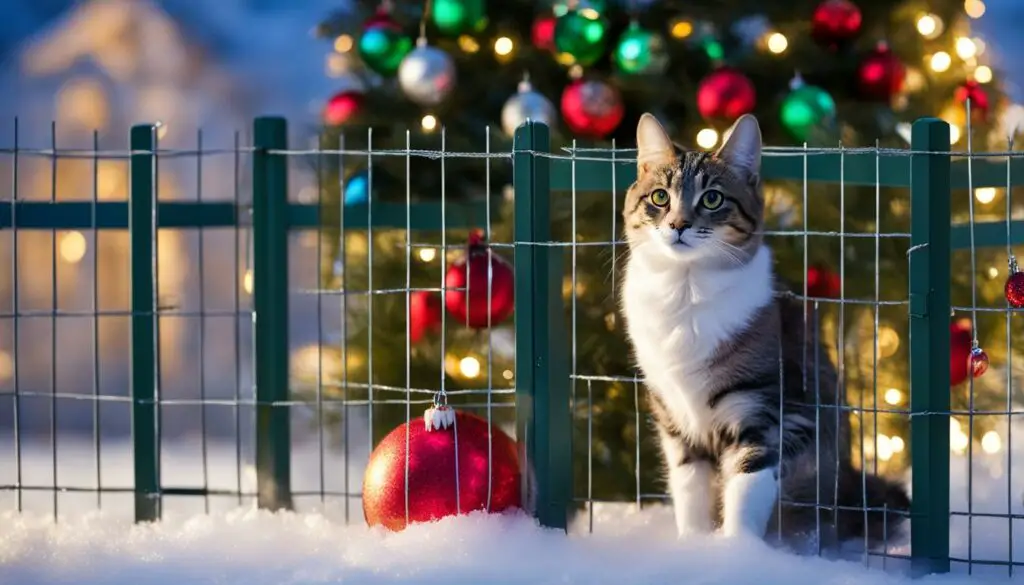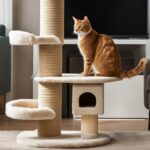During the holiday season, many cat owners face the challenge of keeping their feline friends away from the Christmas tree. Not only can cats be attracted to the shiny ornaments and dangling decorations, but there are also potential dangers associated with the tree itself. In this article, I will share expert tips on how to cat-proof your Christmas tree and create a safe and festive environment for both you and your furry companion.
Key Takeaways:
- Understanding why cats are attracted to Christmas trees can help in implementing effective strategies to discourage their behavior.
- Christmas trees can pose potential dangers to cats, such as toxic tree types, broken ornaments, and electrical hazards.
- Preparing the Christmas tree by anchoring it securely, setting it up in a cat-free area, and providing alternative play areas can help keep your cat away from the tree.
- Using cat deterrents, choosing cat-friendly decorations, and securing electrical wires and lighting are important safety measures to prevent cat-related incidents with the tree.
- Supervising your cat, providing training, and rewarding positive behavior can establish boundaries and discourage your cat from approaching the Christmas tree.
Why Cats are Attracted to Christmas Trees
Cats are naturally drawn to Christmas trees for a variety of reasons. The sparkling lights, bouncing decorations, and scent of evergreen make the tree an irresistible playground for our feline friends. According to cat experts, a Christmas tree resembles a giant cat tree, providing climbing opportunities and hiding places that satisfy their instinctual needs. Additionally, the shiny ornaments and flickering lights can be highly stimulating for cats.
Understanding why cats are attracted to Christmas trees can help us come up with effective strategies to discourage their behavior and keep them away from the tree.
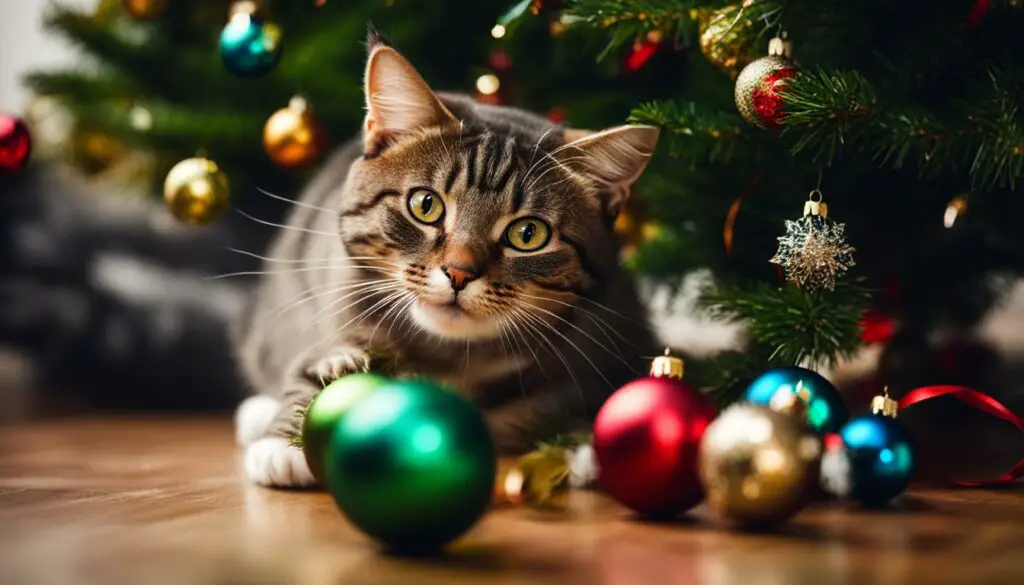
Potential Dangers of Christmas Trees for Cats
While Christmas trees may seem harmless, they can pose potential dangers to cats. Some types of fresh Christmas trees can be mildly toxic to cats, and the oils they produce may irritate the cat’s mouth and digestive tract. Ingesting the bark or needles of a Christmas tree can lead to digestive upset, vomiting, and diarrhea. Drinking water from the tree base can also be unsafe, as it may be contaminated with bacteria or chemicals. Furthermore, broken glass ornaments, electrical cords, and small decorations can all be hazardous if chewed or swallowed by cats. It is important to be aware of these risks and take appropriate measures to ensure the safety of your cat.
When it comes to Christmas trees, it’s crucial to understand the potential hazards they present to our feline friends. Cats are curious creatures, and the shiny ornaments and dangling decorations can be irresistible to them. However, it’s essential to be vigilant and take steps to prevent any accidents or illnesses.
One of the main concerns with Christmas trees is the toxicity of some types of trees to cats. The oils produced by certain species, such as pine or fir, can be mildly toxic and cause irritation in a cat’s mouth and digestive system. Ingesting the bark or needles can lead to digestive upset, including vomiting and diarrhea. It’s important to select a tree variety that is safe for cats or consider opting for an artificial tree to eliminate this risk.
| Potential Dangers of Christmas Trees for Cats | Preventive Measures |
|---|---|
| Toxicity of certain tree species | Choose cat-safe tree varieties or opt for an artificial tree |
| Contaminated tree water | Use a tree skirt or cover the base to prevent access to the water |
| Broken glass ornaments | Use cat-friendly decorations and secure ornaments tightly to prevent them from falling |
| Electrical cords | Secure cords and use cord covers or deterrent sprays |
| Small decorations | Avoid using small decorations that can be easily chewed or swallowed |
In addition to the toxicity of certain tree species, there are other potential hazards associated with Christmas trees for cats. The water in the tree base can become contaminated with bacteria or chemicals, posing a risk if your cat drinks from it. To prevent access to the water, consider using a tree skirt or covering the base of the tree. This will create a barrier and ensure that your cat cannot reach the water.
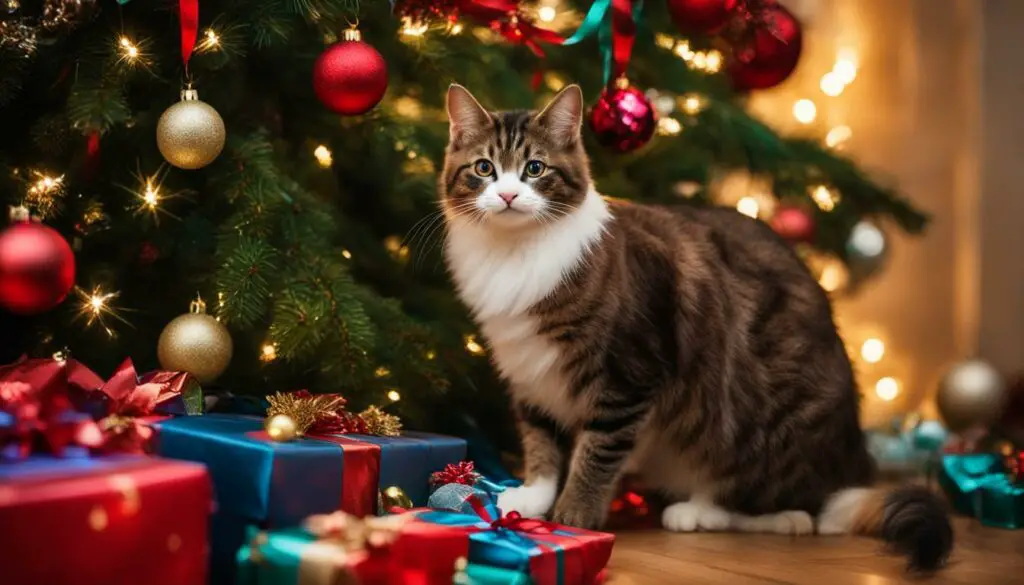
Another common danger is broken glass ornaments. Cats are naturally curious and may attempt to bat or play with ornaments, leading to accidental breakage. To prevent this, opt for cat-friendly decorations that are less likely to break. Additionally, ensure that ornaments are securely attached to the tree to reduce the risk of them falling and shattering.
Conclusion
It is essential to be aware of the potential dangers that Christmas trees can pose to cats. By understanding these risks and taking preventive measures, you can create a safe environment for your feline friend during the holiday season. Choose cat-safe tree varieties or opt for an artificial tree, cover the tree base to prevent access to contaminated water, use cat-friendly decorations, secure electrical cords, and avoid small decorations that can be easily chewed or swallowed. By keeping these precautions in mind, you can enjoy a festive and worry-free holiday season with your cat.
Preparing the Christmas Tree
Before decorating the Christmas tree, it is important to take some steps to make it less appealing to your cat. One option is to set up the tree a few days before adding any decorations, giving your cat time to investigate and satisfy their curiosity. It is also recommended to anchor the tree securely to the wall or ceiling to prevent it from toppling over if your cat attempts to climb it. Placing the tree in an area free of launch zones, such as furniture and window sills, can also deter your cat from jumping onto the tree. By taking these precautions, you can create a cat-friendly Christmas tree setup that reduces the likelihood of your cat causing any mischief.
When preparing the Christmas tree, keep in mind that cats are often attracted to the ornaments and decorations. To minimize the risk of your cat knocking them off, consider using lightweight, non-breakable ornaments instead of fragile glass ones. Secure ornaments firmly to the branches using metal hooks or strings, ensuring they cannot be easily swatted or pulled off by your curious cat. Avoid using tinsel or garlands, as these can pose a choking hazard if your cat decides to chew or swallow them.
Another important aspect of preparing the Christmas tree for your cat is to avoid using any potentially harmful substances. Keep in mind that certain tree preservatives or artificial snow sprays may contain chemicals that can be toxic to cats. Opt for cat-friendly alternatives and read labels carefully to ensure that the products you use are safe for your feline friend. By making mindful choices and taking the necessary precautions, you can create a cat-proof Christmas tree that enhances the holiday spirit without putting your cat at risk.
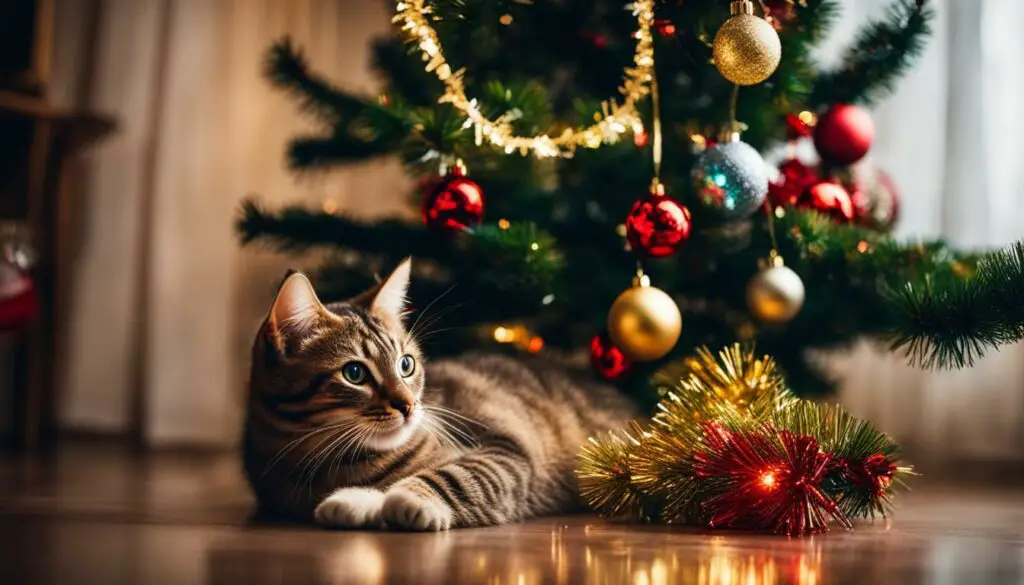
Cat-Friendly Christmas Tree Setup Tips:
- Set up the tree a few days in advance to let your cat explore and satisfy their curiosity.
- Securely anchor the tree to prevent it from toppling over if your cat tries to climb it.
- Place the tree in an area free of launch zones, such as furniture and window sills.
- Use lightweight, non-breakable ornaments and secure them firmly to the branches.
- Avoid using tinsel, garlands, or other decorations that can be a choking hazard.
- Read labels carefully and avoid using potentially toxic tree preservatives or artificial snow sprays.
Using Cat Deterrents
When it comes to keeping your cat away from the Christmas tree, there are several effective cat deterrents that you can use. One option is to invest in a safe and natural cat deterrent spray that is specifically formulated to discourage cats from approaching the tree. Look for pet-safe products like NaturVet Bitter Yuck! No Chew Spray, which can be applied to the bottom half of the tree. These sprays emit a taste that cats find unpleasant, deterring them from getting too close to the tree without leaving behind any noticeable odor for humans.
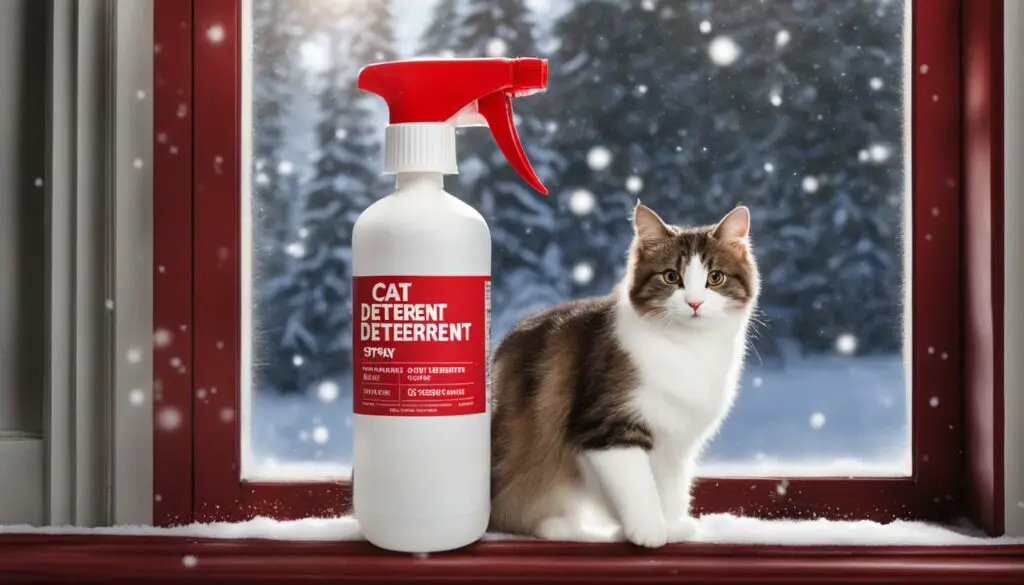
Another cat deterrent option is to use aluminum foil as a physical barrier. Cats dislike the texture of foil, so wrapping the trunk base and floor around the tree with foil can discourage them from approaching it. Additionally, you can try placing citrus peels or cotton balls soaked in citrus oil around the base of the tree. Cats generally dislike the smell of citrus, making it a natural deterrent.
Using Cat Deterrents Effectively
- Choose a cat deterrent spray that is safe and specifically formulated for cats.
- Apply the deterrent spray to the bottom half of the tree.
- Use aluminum foil to create a physical barrier around the tree.
- Place citrus peels or cotton balls soaked in citrus oil around the base of the tree.
By utilizing these cat deterrents, you can create a barrier that discourages your cat from getting too close to the Christmas tree. However, it’s important to remember that every cat is different, and what works for one may not work for another. It may take some trial and error to find the right combination of deterrents that effectively keeps your cat away from the tree. With patience and consistency, you can create a safe and festive environment for both you and your feline companion during the holiday season.
Creating a Cat-Friendly Environment
When it comes to keeping your cat away from the Christmas tree, providing alternative play areas is key. By offering your feline friend dedicated spaces for climbing, scratching, and exploring, you can redirect their attention and minimize their interest in the tree. Set up perches or a multilevel play structure in a separate area of the room, away from the tree. Incorporate toys, scratching posts, and cat-safe plants, such as catnip, to satisfy their natural instincts. By providing these alternative play areas, you can create an environment that engages your cat and reduces their desire to investigate the Christmas tree.
Additionally, consider using interactive toys and puzzles to keep your cat mentally stimulated. Toys that dispense treats or require problem-solving skills can help divert their attention from the tree. Engaging your cat in regular playtime sessions is also essential. Spend quality time playing with your cat using interactive toys, such as feather wands or laser pointers, to burn off excess energy and keep them entertained.
Creating a cat-friendly environment extends beyond play areas. It’s important to ensure your home meets your cat’s needs in terms of comfort and safety. Provide cozy resting spots, such as soft beds or blankets, where your cat can relax away from the tree. Place food and water bowls in a separate area to avoid any potential contamination from the tree. Finally, maintain a calm and peaceful atmosphere. Loud noises, frequent visitors, and other stressful stimuli can contribute to your cat’s desire to seek refuge in the tree. By creating a serene environment, you can help minimize their interest in the Christmas tree and promote a harmonious holiday season for both you and your cat.
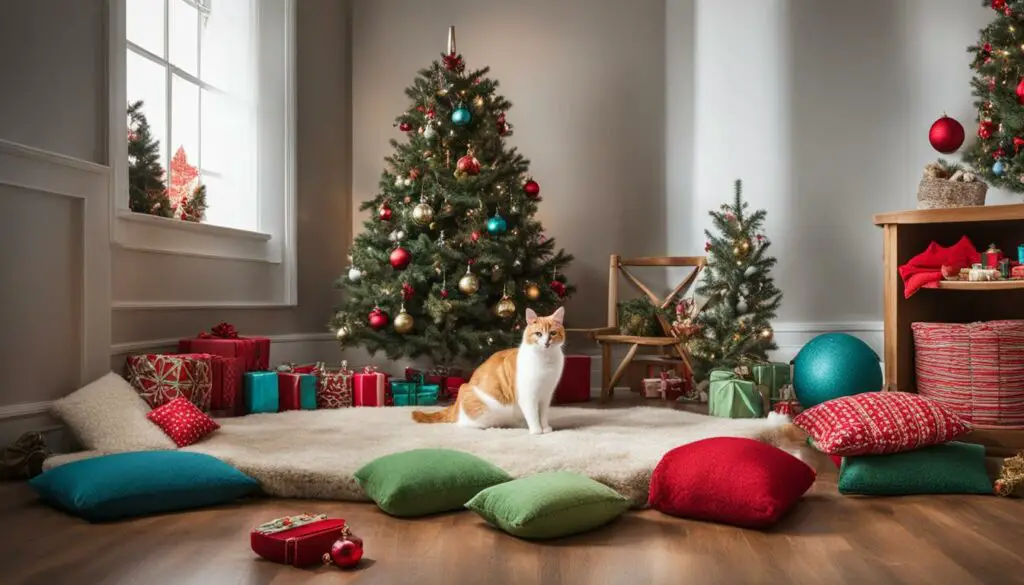
Creating a Cat-Friendly Environment: Tips
- Set up dedicated play areas with perches, scratching posts, and cat-safe plants.
- Use interactive toys and puzzles to mentally stimulate your cat.
- Engage in regular playtime sessions to burn off excess energy.
- Provide cozy resting spots away from the tree.
- Place food and water bowls in a separate area.
- Create a calm and peaceful atmosphere.
Choosing Cat-Friendly Decorations
When it comes to decorating your Christmas tree, choosing cat-friendly decorations is essential in creating a safe and enjoyable environment for your furry friend. By selecting ornaments and decorations that are less likely to attract your cat’s attention, you can minimize the risk of accidents or injuries involving the tree. Here are some tips on how to make your Christmas tree cat-friendly:
- Opt for cat-friendly ornaments: Choose ornaments that are less breakable and avoid using glass ornaments that can shatter if knocked off the tree. Instead, opt for plastic or shatter-proof ornaments that are more durable and safe for curious paws.
- Secure your ornaments: Use metal hooks that clamp to the branches to securely attach ornaments to the tree. This makes it difficult for your cat to bat them off and reduces the risk of them being chewed or swallowed.
- Avoid tinsel and garlands: These decorations can pose a choking hazard if swallowed by your cat. It’s best to steer clear of tinsel and garlands altogether to ensure your cat’s safety.
By carefully selecting cat-friendly decorations, you can create a beautiful Christmas tree that is safe for your cat to be around.
Table: Cat-Friendly Christmas Tree Decorations
| Decoration | Cat-Friendly Alternative |
|---|---|
| Glass ornaments | Plastic or shatter-proof ornaments |
| Tinsel | Non-toxic fabric or ribbon garlands |
| Bells | Fabric or plush ornaments |
| Small decorations | Larger, non-chewable ornaments |
By following these guidelines and choosing cat-friendly decorations, you can ensure that your Christmas tree is a safe and enjoyable part of your holiday festivities for both you and your cat.
Ideal Location and Placement of the Christmas Tree
When it comes to keeping your cat away from the Christmas tree, the location and placement of the tree play a crucial role. Choose an ideal spot that is away from ledges, furniture, and windowsills that your cat can use as launch pads to reach the tree. By placing the tree strategically, you can create a physical barrier that discourages your cat from approaching it.
It is also important to avoid placing the tree too close to a fireplace, air vent, or direct heat source. Cats may be tempted to find a warm napping spot on the tree, which can lead to accidents or injuries. Additionally, consider setting up the Christmas tree in a room that can be closed off from your cat’s access. This will allow you to supervise the interactions between your cat and the tree more effectively.

Furthermore, if you have limited space or want to provide extra protection for your tree, you may opt for a tabletop tree. Tabletop trees can be placed on elevated surfaces or in bedrooms when not supervised, making it more difficult for your cat to reach them.
By carefully considering the location and placement of the Christmas tree, you can create a physical barrier that deters your cat from approaching it, ensuring a safe and festive holiday season for everyone.
Using Repellents and Scents
One of the effective ways to deter your cat from the Christmas tree is to use repellents and scents that cats find unpleasant. Cat repellent sprays specifically formulated for this purpose can be purchased at pet supply stores. These sprays emit scents that cats dislike, without leaving any noticeable odor for humans. Simply spray the tree with the repellent spray to create a barrier that discourages your cat from approaching it.
Citrus odors, such as lemon or orange, can also be effective in deterring cats. Cats generally dislike the smell of citrus, making it a natural deterrent. You can hang dried slices of orange or lemon around the base of the tree or use citrus-scented pet repellent sprays to create an environment that cats find less appealing.
Cats dislike the smell of citrus, making it an effective natural deterrent.
By utilizing repellents and scents, you can create an environment that cats find less appealing and discourage their interest in the Christmas tree. However, it is important to note that while these methods can be effective for many cats, they may not work for all. Every cat is unique and may have different preferences and sensitivities, so it may require some trial and error to find the right repellent or scent that works for your cat.
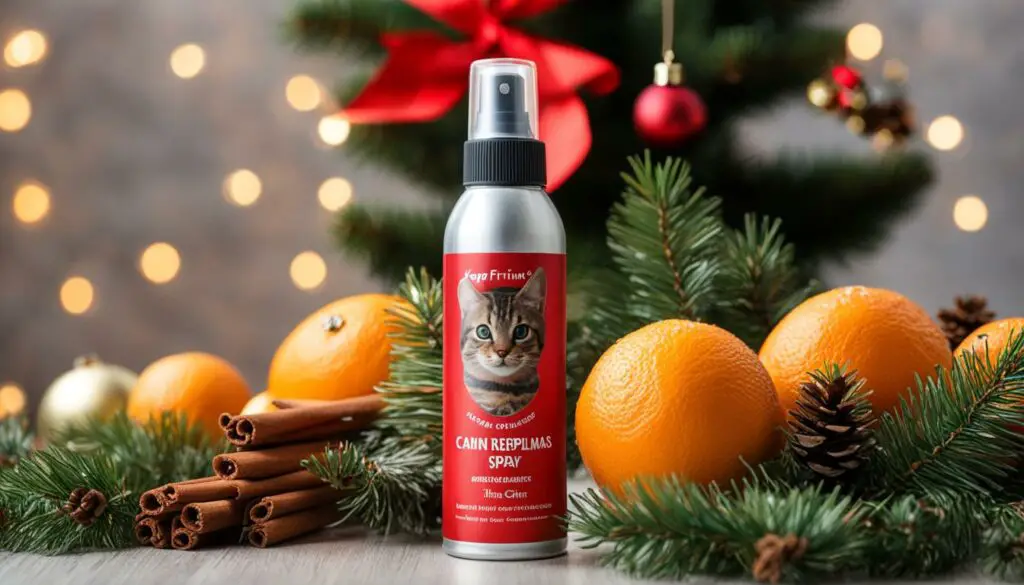
Table: Pros and Cons of Cat Repellent Sprays
| Pros | Cons |
|---|---|
| Effectively deters cats from approaching the Christmas tree | May not work for all cats |
| Safe and non-toxic for cats when used as directed | Some sprays may have a temporary odor that is noticeable to humans |
| Easy to apply and reapply as needed | May require frequent reapplication to maintain effectiveness |
| Can be used on other surfaces to discourage scratching or inappropriate behavior | May not be as effective on cats with strong scent preferences |
Using repellents and scents can be a helpful tool in keeping your cat away from the Christmas tree. However, it is important to combine this approach with other strategies, such as providing alternative play areas and supervising your cat’s interactions with the tree, to create a comprehensive cat-proofing plan.
Securing Electrical Wires and Lighting
When it comes to setting up your Christmas tree, it’s important to take precautions to ensure the safety of your cat around electrical wires and lighting. Cats are curious creatures and may be tempted to play with or chew on exposed wires, which can lead to electric shock or injury. To prevent this, make sure to secure electrical wires and hide them from your cat’s reach.
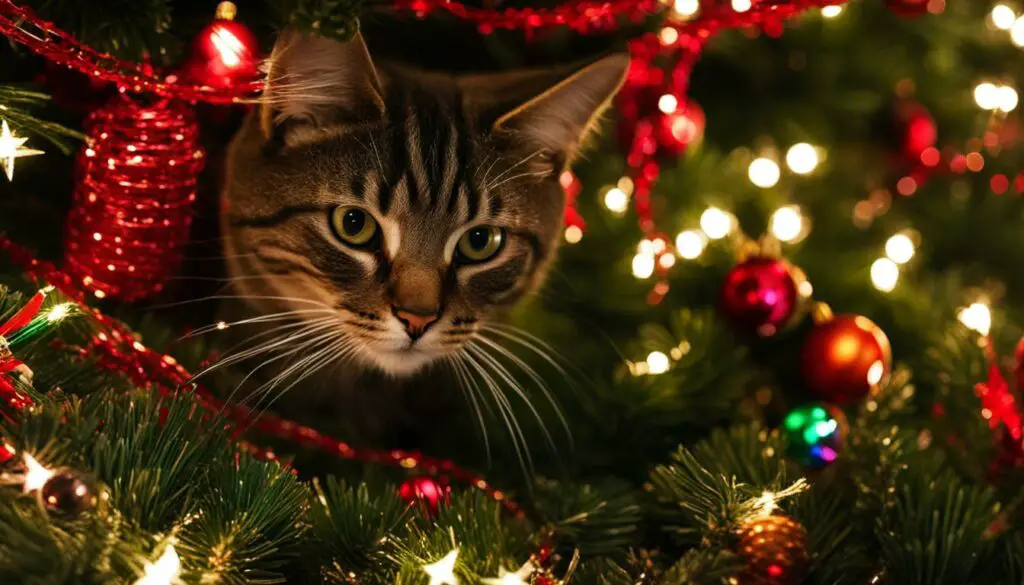
One effective way to secure electrical wires is by taping them down to the floor or using wire covers for added protection. This will prevent your cat from accessing the wires and reduce the risk of them getting tangled or chewed on. Additionally, positioning the Christmas tree lights mid-branch and hiding the wires can make them less accessible to your cat, further minimizing the temptation to play with them.
Remember to always turn off the Christmas tree lights when you are not present in the room to supervise. This will prevent any accidents or potential hazards that may arise from unsupervised play. By taking these precautions and securing electrical wires and lighting, you can create a safe environment for your cat during the holiday season.
Distractions and Diversion
When it comes to keeping your cat away from the Christmas tree, providing distractions and engaging them in playtime can be an effective strategy. By offering alternative outlets for their energy and curiosity, you can redirect their focus away from the tree and minimize their interest in it.
One way to distract your cat is by placing their favorite toys in the same room as the tree. This can help shift their attention towards the toys and away from the shiny ornaments and dangling decorations. Additionally, having a scratching post nearby can provide an alternative scratching surface for your cat, further reducing their interest in the tree.
Playing with your cat regularly is also important to burn off excess energy and prevent boredom. Set aside dedicated playtime sessions each day to engage your cat in interactive play, using toys that simulate hunting behaviors. This not only provides mental and physical stimulation for your cat but also helps tire them out, making them less likely to engage in mischief around the tree.
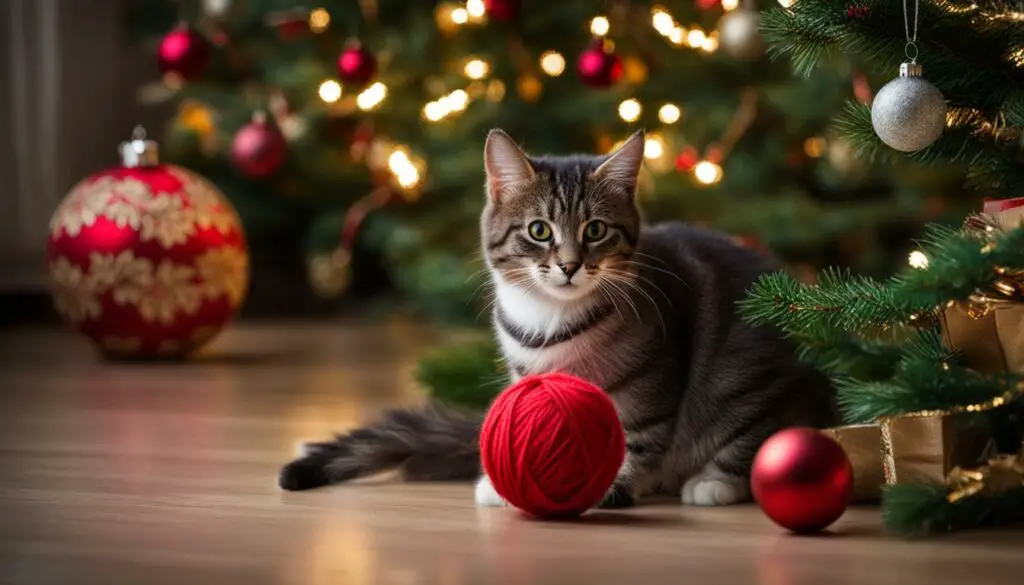
Providing distractions and engaging in playtime can help keep your cat entertained and less interested in the Christmas tree.
Benefits of Distractions and Playtime
Distracting your cat from the Christmas tree and engaging them in playtime can have several benefits. Firstly, it helps redirect their natural instincts and behaviors towards more appropriate outlets, such as toys and scratching posts. This can prevent destructive behavior, such as climbing the tree or batting ornaments off.
Secondly, playtime provides mental and physical stimulation for your cat, helping to keep them happy and healthy. Regular play sessions can alleviate boredom, reduce stress, and improve their overall well-being. It also strengthens the bond between you and your cat, as it allows for quality interaction and positive reinforcement.
Lastly, by providing distractions and engaging your cat in playtime, you are creating a positive environment that encourages good behavior and discourages unwanted behaviors around the Christmas tree. This can contribute to a harmonious coexistence between your cat and the festive decorations in your home.
Choosing the Right Tree
When it comes to deciding between an artificial or real Christmas tree, cat owners should consider the needs and safety of their furry friends. Artificial trees are generally a safer option for cats as their needles are less sharp and they pose fewer risks if chewed or ingested. However, if you opt for a real tree, there are a few things to keep in mind.
A tall and skinny tree is less appealing for cats to climb, reducing the chances of accidents. It’s important to avoid using potentially toxic decorations, such as artificial snow, and be cautious with any scents or chemicals that could be harmful to your cat. Additionally, ensure that the tree is securely anchored and positioned away from ledges and furniture that your cat could use as a launching pad.
Creating a cat-friendly environment during the holiday season is essential for keeping your feline friend safe and happy. By choosing the right tree and decorations, you can minimize the risks associated with the Christmas tree and ensure a joyful holiday season for both you and your cat.
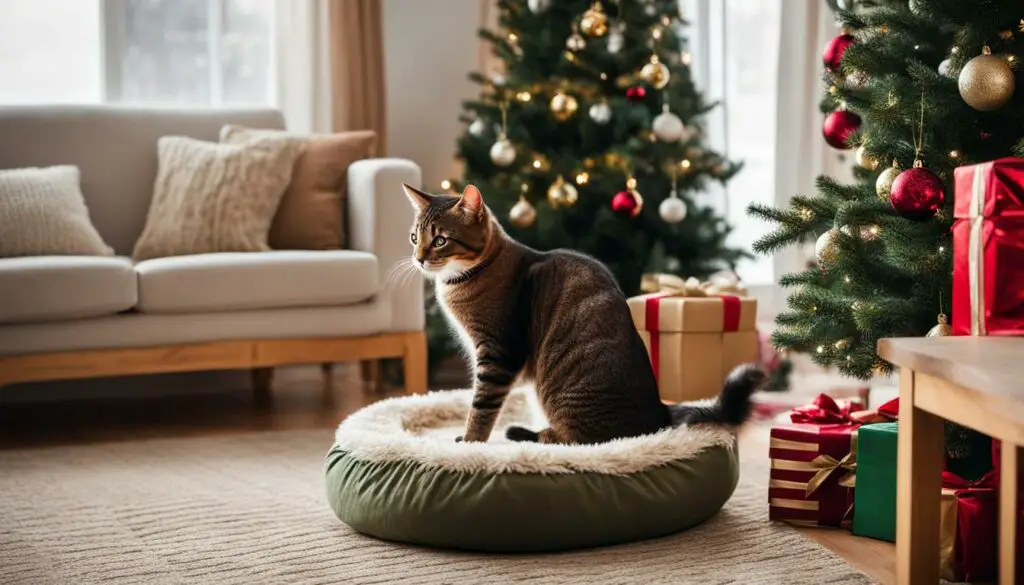
Table: Artificial vs. Real Christmas Tree for Cats
| Factor | Artificial Tree | Real Tree |
|---|---|---|
| Safety | Artificial trees have blunt needles and pose fewer risks if chewed or ingested. | Real trees can have sharp needles that could cause harm if chewed or ingested. Choose a tall and skinny tree to discourage climbing. |
| Toxicity | Artificial trees are generally non-toxic to cats. | Some types of real trees can be mildly toxic to cats. Avoid using potentially toxic decorations. |
| Climbing Appeal | Artificial trees are less appealing for cats to climb. | Choose a tall and skinny tree to reduce the climbing appeal. |
Table: Artificial vs. Real Christmas Tree for Cats
Supervision and Training
When it comes to keeping your cat away from the Christmas tree, supervision and training are key. It’s important to be present and actively monitor your cat’s behavior around the tree, especially during the initial stages of tree setup. By being nearby, you can quickly redirect your cat’s attention if they show any interest in the tree or its decorations.
Supervision also allows you to identify any potential hazards that may arise. For example, if your cat starts chewing on wires or batting at fragile ornaments, you can intervene immediately to prevent accidents or injuries. Through consistent supervision, you can reinforce boundaries and teach your cat that the Christmas tree is off-limits.
In addition to supervision, consider implementing training techniques to further discourage your cat from approaching the tree. Positive reinforcement can be highly effective in shaping desired behaviors. When your cat avoids the tree or shows disinterest, reward them with praise, treats, or playtime. This helps your cat associate staying away from the tree with positive experiences and reinforces their training.
It’s important to remember that training takes time and patience. Be consistent in your approach, and avoid punishment or scolding as it can create anxiety or fear in your cat. With patience and positive reinforcement, you can successfully train your cat to stay away from the Christmas tree.
Table: Tips for Supervising and Training Cats around the Christmas Tree
| Tip | Description |
|---|---|
| Be present | Stay near the tree to supervise your cat’s behavior and quickly redirect their attention if needed. |
| Identify hazards | Watch for any potential dangers, such as chewing on wires or batting at fragile ornaments, and intervene to prevent accidents. |
| Use positive reinforcement | Reward your cat with praise, treats, or playtime when they stay away from the tree to reinforce desired behavior. |
| Be consistent | Stick to a consistent training approach and avoid punishment or scolding, as it can create anxiety or fear in your cat. |
Conclusion
In conclusion, cat-proofing your Christmas tree is essential to ensure the safety of your feline friend and maintain the festive atmosphere in your home. By understanding why cats are attracted to Christmas trees and implementing the right strategies, you can create a cat-friendly environment that discourages their interest in the tree.
Start by preparing the tree and setting it up in a secure location, away from furniture and launch zones. Utilize cat deterrents, such as safe sprays or aluminum foil, to create a barrier that keeps your cat at a distance. Provide alternative play areas and distractions to redirect your cat’s energy and curiosity. Choose cat-friendly decorations that are less likely to break or pose a choking hazard.
Secure electrical wires and lighting, and always supervise your cat’s interactions with the tree. Use scents and repellents that cats find unpleasant to discourage them from approaching the tree. And don’t forget to provide consistent training and positive reinforcement to reinforce the boundaries.
With these expert tips and precautions, you can keep your cat out of the Christmas tree and ensure a joyful and safe holiday season for everyone involved. Happy holidays!
FAQ
Why are cats attracted to Christmas trees?
Cats are naturally drawn to the sparkling lights, bouncing decorations, and scent of evergreen, making the tree an irresistible playground for them.
Are Christmas trees toxic to cats?
Some types of fresh Christmas trees can be mildly toxic to cats, and ingesting the bark or needles can lead to digestive upset. Additionally, drinking water from the tree base can be unsafe.
How can I cat-proof my Christmas tree?
Some ways to cat-proof your Christmas tree include setting it up a few days before decorating, anchoring it securely to the wall or ceiling, and placing it in an area free of launch zones.
What are cat deterrents for the Christmas tree?
Cat deterrents for the Christmas tree include safe and natural sprays specifically formulated to discourage cats from approaching the tree. Using aluminum foil to wrap the trunk base and floor around the tree can also be effective.
How can I provide alternative play areas for my cat?
Set up perches or a multilevel play structure in a separate area of the room, away from the tree. Include toys, scratching posts, and cat-safe plants to satisfy your cat’s desire to climb, scratch, and explore.
What are cat-friendly decorations for the Christmas tree?
Opt for less breakable ornaments and avoid using glass ornaments. Securely attach ornaments to the tree using metal hooks. Avoid using tinsel or garlands, as they can pose a choking hazard.
Where should I place the Christmas tree to keep my cat away?
Choose a spot away from ledges, furniture, and windowsills that your cat can use as launch pads. Avoid placing the tree too close to a fireplace or direct heat source. Consider setting it up in a room that can be closed off or using a tabletop tree.
How can I use repellents and scents to deter my cat?
Spraying the tree with a cat repellent spray or using citrus odors, such as lemon or orange, can help deter cats from approaching the tree.
How can I secure electrical wires and lighting associated with the Christmas tree?
Tape down excess wires, use wire covers or piping to cover exposed wires, and position the lights mid-branch to hide the wires. Always turn off the Christmas tree lights when not supervised.
What can I do to distract my cat from the Christmas tree?
Provide alternative play areas with toys and scratching posts. Engage in playtime with your cat to burn off excess energy and prevent boredom.
Should I choose an artificial or real Christmas tree?
Artificial trees are generally safer for cats, but if you choose a real tree, opt for a tall and skinny one. Avoid using potentially toxic decorations and be cautious with any scents or chemicals.
How can I train my cat to stay away from the Christmas tree?
Use positive reinforcement techniques to redirect your cat’s behavior and reward them for staying away from the tree. Use deterrents and temporary barriers when you are not present to supervise.

